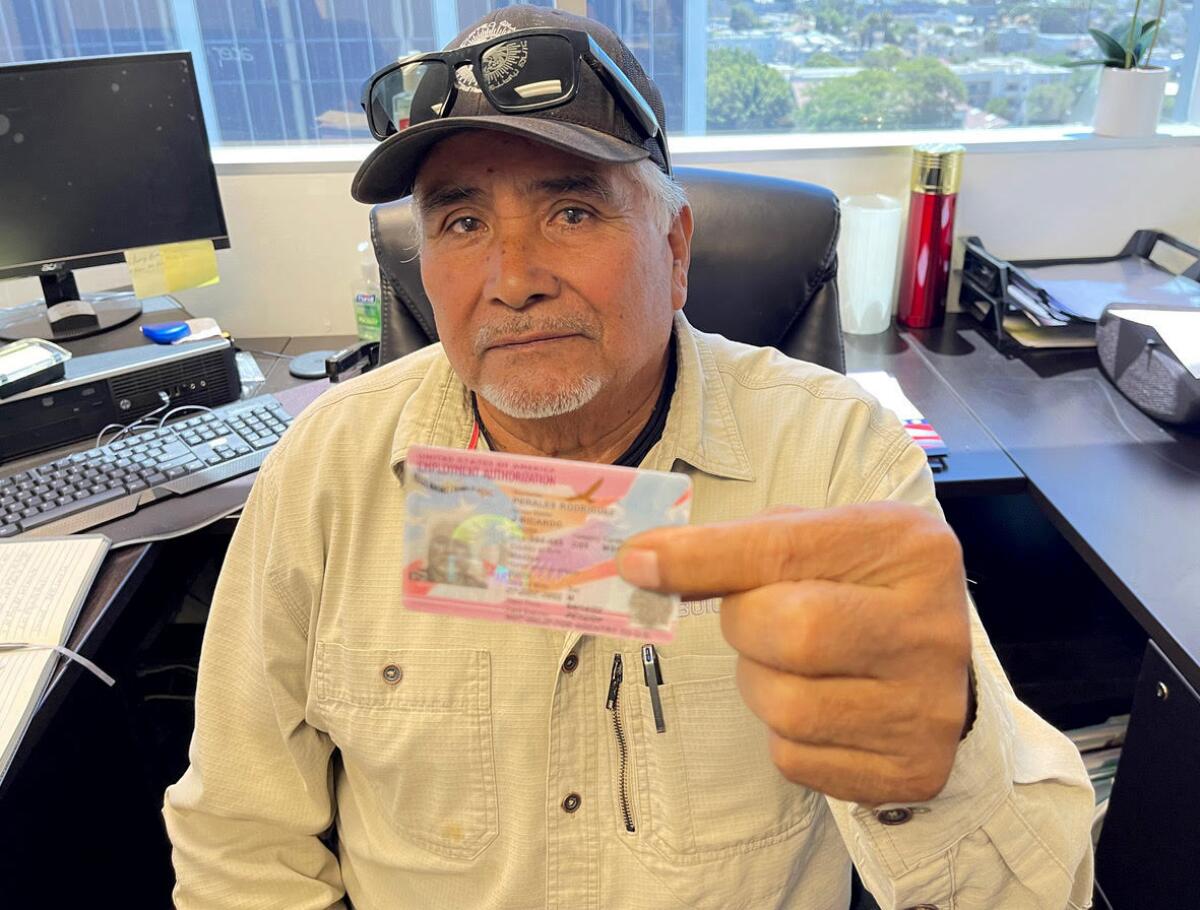His late wife left her Mexican immigrant husband a precious gift: U.S. permanent residency

Simona Rodríguez’s sudden death in December 2020 jolted her husband, Ricardo.
The couple had shared 42 years of their lives. They’d raised two children after immigrating to the United States. They’d dreamed of visiting relatives in Mexico, but Ricardo lacked the legal documents that would’ve given him the freedom to travel abroad.
Yet, since Simona’s death, the 71-year-old immigrant has discovered that his beloved wife left him an unexpected and precious gift: a permanent resident card.
The card, which he was able to obtain through filing Form I-360, known as a Petition for Amerasian, Widow(er), or Special Immigrant, which can be procured through United States Citizenship and Immigration Services (USCIS), is a versatile document that certain immigrants can file with the agency as part of their green card application process.
It can be submitted by an array of noncitizens, including members of the U.S. armed forces; Amerasian children of certain U.S. service members who served during the Korean and Indochina wars; Panama Canal Zone government employees; Afghan or Iraqi nationals who worked for or on behalf of the U.S. government as an interpreter; immigrants who were victims of violence or extreme cruelty by a U.S. citizen spouse or relative; and the widow or widower of a U.S. citizen.
When Simona became a U.S. citizen seven years ago, she wanted to submit an I-130 application — a predecessor of the I-360 — on behalf of her husband for permanent residency status. But, out of his masculine pride, Ricardo Rodríguez had refused his wife’s help.
“I grew up with the mentality and teaching that a man should provide and help his partner, and not the other way around,” he said. “I did not want to bother Simona in a process that can result in several visits to the immigration lawyer, the collection of personal documents and the tedium of filling out documentation for the immigration office.”
He also harbored vague, ultimately futile hopes that the United States might someday get around to enacting comprehensive immigration reform. But several U.S. presidents came and went with no change.
“By the time I wanted to submit my request, it was too late. The pandemic arrived and everything closed,” Rodríguez said.
Despite the potentially life-changing and even lifesaving benefits it confers, the I-360 petition is relatively underutilized, analysts say. During the fiscal year 2022, USCIS received some 80,107 I-360 applications — about 39,926 were approved and 7,409 denied.
Elizabeth Uribe, an immigration lawyer in Los Angeles County, said that many immigrants tend to get information about citizenship matters from relatives and friends, who may provide incomplete or inaccurate guidance. For example, she said, some immigrants believe that they have to be married to a U.S. citizen for more than two years in order to apply for the petition, although USCIS did away with that requirement in 2009.
Other immigrants, fearing that a change in federal administrations or USCIS procedures could land their petitions in a prolonged state of limbo, may prefer to remain in the shadows, Uribe said.
And although activist groups have devoted resources to educating immigrants about programs that grant limited protections and rights, such as Deferred Action for Childhood Arrivals (DACA) status and temporary protected status (TPS), Uribe said she has never seen any immigrant advocacy organization educate the community about I-360.
“I definitely think not a lot of people are benefiting from this form because there could be more cases. Especially with the pandemic, where a lot of people have died, and there are people who have been widowed,” she said.
In cases involving a U.S. citizen who dies without having presented the necessary paperwork to request citizenship for her or his spouse, the surviving partner may complete the paperwork. This applies both to heterosexual and same-sex marriages.
“As a condition, the person making the petition must present documents that he was married to the citizen, they never separated, and he never remarried. Another essential requirement is that said petition must be sent within two years of the death of the spouse,” said Hilda Ramirez, director of operations of the Law Offices of Sergio Siderman in Los Angeles.
Sharon Scheidhauer, a spokeswoman for USCIS, said that the various classifications of immigrants who can submit an I-360 form are not broken down, so no specific figures exist for widows or widowers requesting the form.
There is no requirement that those submitting a form must reside in the United States. But Ramirez said that surviving spouses without documents must submit a petition as soon as possible, because the deadline clock begins ticking immediately upon the death of the U.S. citizen spouse.
“The biggest problem that the community has is that they don’t know that relief exists and they let a lot of time pass,” Ramirez said. “In fact, many are denied residency through this process because they miss the time limit, do not qualify for a waiver if they entered the country illegally or have a criminal history.”
Karla Aguayo, an attorney with the Coalition for Humane Immigrant Rights, said the problem is that this type of relief is available only for the limited number of people who enter the United States with a valid visa.
“When a person without legal documents has a citizen partner, the most obvious thing is that he applies for her permanent residence while he is married,” she said. “Very few people wait to regularize their legal stay” until the citizen spouse dies, “and in fact not many know that they have the right to apply if they entered with a visa,” she added.
When Simona and Ricardo Rodríguez arrived in the United States in August 1985, they had known each other for five years and had been married for four. The couple met in the city of Culiacán, in northwestern Mexico, where Ricardo was working as a fisheries inspector, and she was a widow who had given birth to six children in the United States. After being widowed, Simona had moved back to Sinaloa, the state of her birth, and worked as a beer vendor at a small store.
“She looked so pretty, and at first glance we liked each other, and I said to myself, ‘She has to be my girlfriend.’ So I started to win her over,” Rodríguez reminisced. “By October 1981 we had twins.”
In 1985, the couple had the opportunity to visit Simona’s brother in Los Angeles. Seeing that the brother earned good money in construction, Rodríguez extended his visit from 15 days to several months. The couple and their children settled in Lynwood, hoping to earn enough money to return quickly to Mexico.
But, in the familiar Catch-22 of immigrants lacking documents while trying to build a nest egg in the United States, they put off returning home because they feared not being able to cross back into the United States.
As the years passed, Simona was able to obtain U.S. citizenship through one of her U.S.-born daughters from Simona’s first marriage. After steadfastly pressuring her husband, Simona finally had convinced Ricardo to submit an I-130 petition. But shortly thereafter, Simona died of a sudden heart attack while visiting family in Culiacán.
“My family called me on the phone and told me that my wife had died. It was painful not being able to see her for the last time, not being able to bury her, not being by her side,” Rodríguez said.
In May 2021, Rodríguez sought legal representation from a lawyer to help him submit his I-360 petition, knowing that Simona would’ve wanted him to become a permanent resident.
“She left me a long-awaited gift, something that I always refused to receive from her,” said Rodríguez. “With my card in hand, I know that she is happy for the step I took.”
As a green card holder, he now has the right to live and work permanently in the United States, travel outside the U.S., apply for citizenship after five years, attend public schools and universities, and receive Social Security and other government benefits.
He plans to travel to Mexico and reunite with family members he has not seen since he left his homeland. One of his first visits will be to his wife’s grave.
“Being a green card holder is about having peace of mind,” he said. “Knowing you don’t have to hide from the immigration authorities. I really see the world with other eyes holding my card … more colorful.”
More to Read
Sign up for Essential California
The most important California stories and recommendations in your inbox every morning.
You may occasionally receive promotional content from the Los Angeles Times.











